Allen Hatcher
Copyright c 2002 by Cambridge University Press
Single paper or electronic copies for noncommercial personal use may be made without explicit permission from the
author or publisher. All other rights reserved.
�
�
Preface
.
.
.
.
.
.
.
.
.
.
.
.
.
.
.
.
.
.
.
.
.
.
.
.
.
.
.
.
.
.
.
.
.
.
ix
Standard Notations xii.
Chapter 0. Some Underlying Geometric Notions .
.
.
.
. 1
Homotopy and Homotopy Type 1. Cell Complexes 5.
Operations on Spaces 8. Two Criteria for Homotopy Equivalence 10.
The Homotopy Extension Property 14.
Chapter 1. The Fundamental Group .
1.1. Basic Constructions
.
.
.
.
.
.
.
.
.
.
.
.
.
.
.
.
.
.
.
.
.
.
.
.
.
.
.
.
.
.
.
.
.
21
25
Paths and Homotopy 25. The Fundamental Group of the Circle 29.
Induced Homomorphisms 34.
1.2. Van Kampen’s Theorem .
.
.
.
.
.
.
.
.
.
.
.
.
.
.
.
.
.
.
40
Free Products of Groups 41. The van Kampen Theorem 43.
Applications to Cell Complexes 50.
1.3. Covering Spaces .
.
.
.
.
.
.
.
.
.
.
.
.
.
.
.
.
.
.
.
.
.
.
.
56
Lifting Properties 60. The Classification of Covering Spaces 63.
Deck Transformations and Group Actions 70.
Additional Topics
1.A. Graphs and Free Groups 83.
1.B. K(G,1) Spaces and Graphs of Groups 87.
�
Chapter 2. Homology .
.
.
.
.
.
.
.
.
.
.
.
.
.
.
.
.
.
.
.
.
2.1. Simplicial and Singular Homology .
Complexes 102. Simplicial Homology 104. Singular Homology 108.
.
.
.
.
.
.
.
.
.
.
.
.
.
97
. 102
Homotopy Invariance 110. Exact Sequences and Excision 113.
The Equivalence of Simplicial and Singular Homology 128.
2.2. Computations and Applications .
.
.
.
.
.
.
.
.
.
.
.
.
. 134
Degree 134. Cellular Homology 137. Mayer-Vietoris Sequences 149.
Homology with Coefficients 153.
2.3. The Formal Viewpoint
.
.
.
.
.
.
.
.
.
.
.
.
.
.
.
.
.
.
.
. 160
Axioms for Homology 160. Categories and Functors 162.
Additional Topics
2.A. Homology and Fundamental Group 166.
2.B. Classical Applications 169.
2.C. Simplicial Approximation 177.
Chapter 3. Cohomology .
3.1. Cohomology Groups .
.
.
.
.
.
.
.
.
.
.
.
.
.
.
.
.
.
.
.
.
.
.
.
.
.
.
.
.
.
.
.
.
.
.
The Universal Coefficient Theorem 190. Cohomology of Spaces 197.
3.2. Cup Product
.
.
.
.
.
.
.
.
.
.
.
.
.
.
.
.
.
.
.
.
.
.
.
.
.
.
.
.
.
. 185
. 190
. 206
The Cohomology Ring 211. A K¨unneth Formula 218.
Spaces with Polynomial Cohomology 224.
3.3. Poincar´e Duality .
.
.
.
.
.
.
.
.
.
.
.
.
.
.
.
.
.
.
.
.
.
.
. 230
Orientations and Homology 233. The Duality Theorem 239.
Connection with Cup Product 249. Other Forms of Duality 252.
Additional Topics
3.A. Universal Coefficients for Homology 261.
3.B. The General K¨unneth Formula 268.
3.C. H–Spaces and Hopf Algebras 281.
3.D. The Cohomology of SO(n) 292.
3.E. Bockstein Homomorphisms 303.
3.F. Limits and Ext 311.
3.G. Transfer Homomorphisms 321.
3.H. Local Coefficients 327.
�
Chapter 4. Homotopy Theory .
4.1. Homotopy Groups
.
.
.
.
.
.
.
.
.
.
.
.
.
.
.
.
.
.
.
.
.
.
.
.
.
.
.
.
.
.
.
.
.
.
.
.
. 337
. 339
Definitions and Basic Constructions 340. Whitehead’s Theorem 346.
Cellular Approximation 348. CW Approximation 352.
4.2. Elementary Methods of Calculation .
.
.
.
.
.
.
.
.
.
.
. 360
Excision for Homotopy Groups 360. The Hurewicz Theorem 366.
Fiber Bundles 375. Stable Homotopy Groups 384.
4.3. Connections with Cohomology
.
.
.
.
.
.
.
.
.
.
.
.
.
. 393
The Homotopy Construction of Cohomology 393. Fibrations 405.
Postnikov Towers 410. Obstruction Theory 415.
Additional Topics
4.A. Basepoints and Homotopy 421.
4.B. The Hopf Invariant 427.
4.C. Minimal Cell Structures 429.
4.D. Cohomology of Fiber Bundles 431.
4.E. The Brown Representability Theorem 448.
4.F. Spectra and Homology Theories 452.
4.G. Gluing Constructions 456.
4.H. Eckmann-Hilton Duality 460.
4.I. Stable Splittings of Spaces 466.
4.J. The Loopspace of a Suspension 470.
4.K. The Dold-Thom Theorem 475.
4.L. Steenrod Squares and Powers 487.
Appendix .
.
.
.
.
.
.
.
.
.
.
.
.
.
.
.
.
.
.
.
.
.
.
.
.
.
.
.
.
.
. 519
Topology of Cell Complexes 519. The Compact-Open Topology 529.
Bibliography .
Index .
.
.
.
.
.
.
.
.
.
.
.
.
.
.
.
.
.
.
.
.
.
.
.
.
.
.
.
.
.
.
.
.
.
.
.
.
.
.
.
.
.
.
.
.
.
.
.
.
.
.
.
.
.
.
.
.
.
.
.
.
.
. 533
. 539
�
This book was written to be a readable introduction to algebraic topology with
rather broad coverage of the subject. The viewpoint is quite classical in spirit, and
stays well within the confines of pure algebraic topology. In a sense, the book could
have been written thirty or forty years ago since virtually everything in it is at least
that old. However, the passage of the intervening years has helped clarify what are
the most important results and techniques. For example, CW complexes have proved
over time to be the most natural class of spaces for algebraic topology, so they are
emphasized here much more than in the books of an earlier generation. This empha-
sis also illustrates the book’s general slant towards geometric, rather than algebraic,
aspects of the subject. The geometry of algebraic topology is so pretty, it would seem
a pity to slight it and to miss all the intuition it provides.
At the elementary level, algebraic topology separates naturally into the two broad
channels of homology and homotopy. This material is here divided into four chap-
ters, roughly according to increasing sophistication, with homotopy split between
Chapters 1 and 4, and homology and its mirror variant cohomology in Chapters 2
and 3. These four chapters do not have to be read in this order, however. One could
begin with homology and perhaps continue with cohomology before turning to ho-
motopy. In the other direction, one could postpone homology and cohomology until
after parts of Chapter 4. If this latter strategy is pushed to its natural limit, homology
and cohomology can be developed just as branches of homotopy theory. Appealing
as this approach is from a strictly logical point of view, it places more demands on the
reader, and since readability is one of the first priorities of the book, this homotopic
interpretation of homology and cohomology is described only after the latter theories
have been developed independently of homotopy theory.
Preceding the four main chapters there is a preliminary Chapter 0 introducing
some of the basic geometric concepts and constructions that play a central role in
both the homological and homotopical sides of the subject. This can either be read
before the other chapters or skipped and referred back to later for specific topics as
they become needed in the subsequent chapters.
Each of the four main chapters concludes with a selection of additional topics that
the reader can sample at will, independent of the basic core of the book contained in
the earlier parts of the chapters. Many of these extra topics are in fact rather important
in the overall scheme of algebraic topology, though they might not fit into the time
�
x
Preface
constraints of a first course. Altogether, these additional topics amount to nearly half
the book, and they are included here both to make the book more comprehensive and
to give the reader who takes the time to delve into them a more substantial sample of
the true richness and beauty of the subject.
Not included in this book is the important but somewhat more sophisticated
topic of spectral sequences.
It was very tempting to include something about this
marvelous tool here, but spectral sequences are such a big topic that it seemed best
to start with them afresh in a new volume. This is tentatively titled ‘Spectral Sequences
in Algebraic Topology’ and is referred to herein as [SSAT]. There is also a third book in
progress, on vector bundles, characteristic classes, and K–theory, which will be largely
independent of [SSAT] and also of much of the present book. This is referred to as
[VBKT], its provisional title being ‘Vector Bundles and K–Theory.’
In terms of prerequisites, the present book assumes the reader has some familiar-
ity with the content of the standard undergraduate courses in algebra and point-set
topology.
In particular, the reader should know about quotient spaces, or identifi-
cation spaces as they are sometimes called, which are quite important for algebraic
topology. Good sources for this concept are the textbooks [Armstrong 1983] and
[J¨anich 1984] listed in the Bibliography.
A book such as this one, whose aim is to present classical material from a rather
classical viewpoint, is not the place to indulge in wild innovation. There is, however,
one small novelty in the exposition that may be worth commenting upon, even though
in the book as a whole it plays a relatively minor role. This is the use of what we call
complexes, which are a mild generalization of the classical notion of a simplicial
complex. The idea is to decompose a space into simplices allowing different faces of
a simplex to coincide and dropping the requirement that simplices are uniquely de-
termined by their vertices. For example, if one takes the standard picture of the torus
as a square with opposite edges identified and divides the square into two triangles
provide a significant improvement in efficiency, which is nice from a pedagogical view-
point since it cuts down on tedious calculations in examples. A more fundamental
by cutting along a diagonal, then the result is a complex structure on the torus
on the torus must have at least 14 triangles, 21 edges, and 7 vertices. So complexes
reason for considering complexes is that they seem to be very natural objects from
simplicial homology, and a number of standard constructions produce complexes
classifying space of a discrete group or category. Historically, complexes were first
the viewpoint of algebraic topology. They are the natural domain of definition for
having 2 triangles, 3 edges, and 1 vertex. By contrast, a simplicial complex structure
rather than simplicial complexes, for instance the singular complex of a space, or the
introduced by Eilenberg and Zilber in 1950 under the name of semisimplicial com-
plexes. This term later came to mean something different, however, and the original
notion seems to have been largely ignored since.
�
Preface
xi
This book will remain available online in electronic form after it has been printed
in the traditional fashion. The web address is
http://www.math.cornell.edu/˜hatcher
One can also find here the parts of the other two books in the sequence that are
currently available. Although the present book has gone through countless revisions,
including the correction of many small errors both typographical and mathematical
found by careful readers of earlier versions, it is inevitable that some errors remain,
so the web page will include a list of corrections to the printed version. With the
electronic version of the book it will be possible not only to incorporate corrections
but also to make more substantial revisions and additions. Readers are encouraged
to send comments and suggestions as well as corrections to the email address posted
on the web page.
�


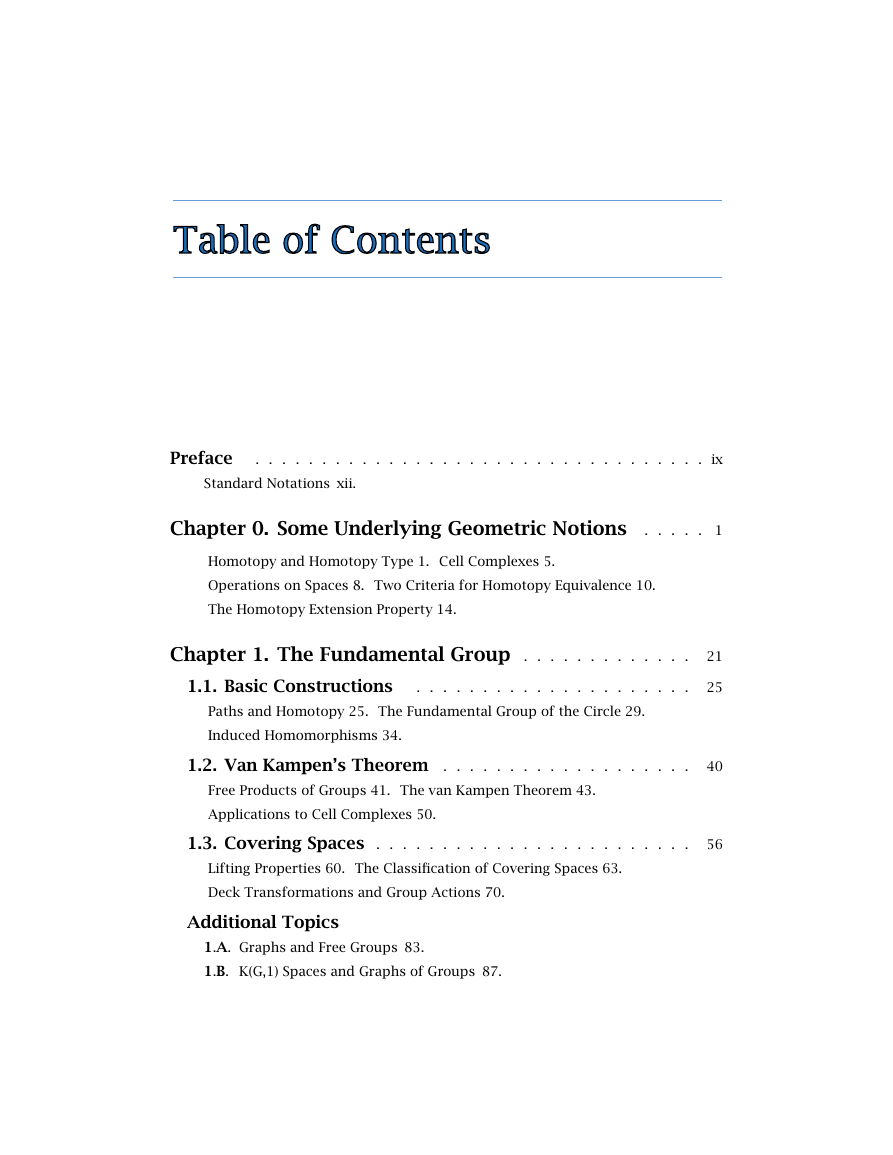

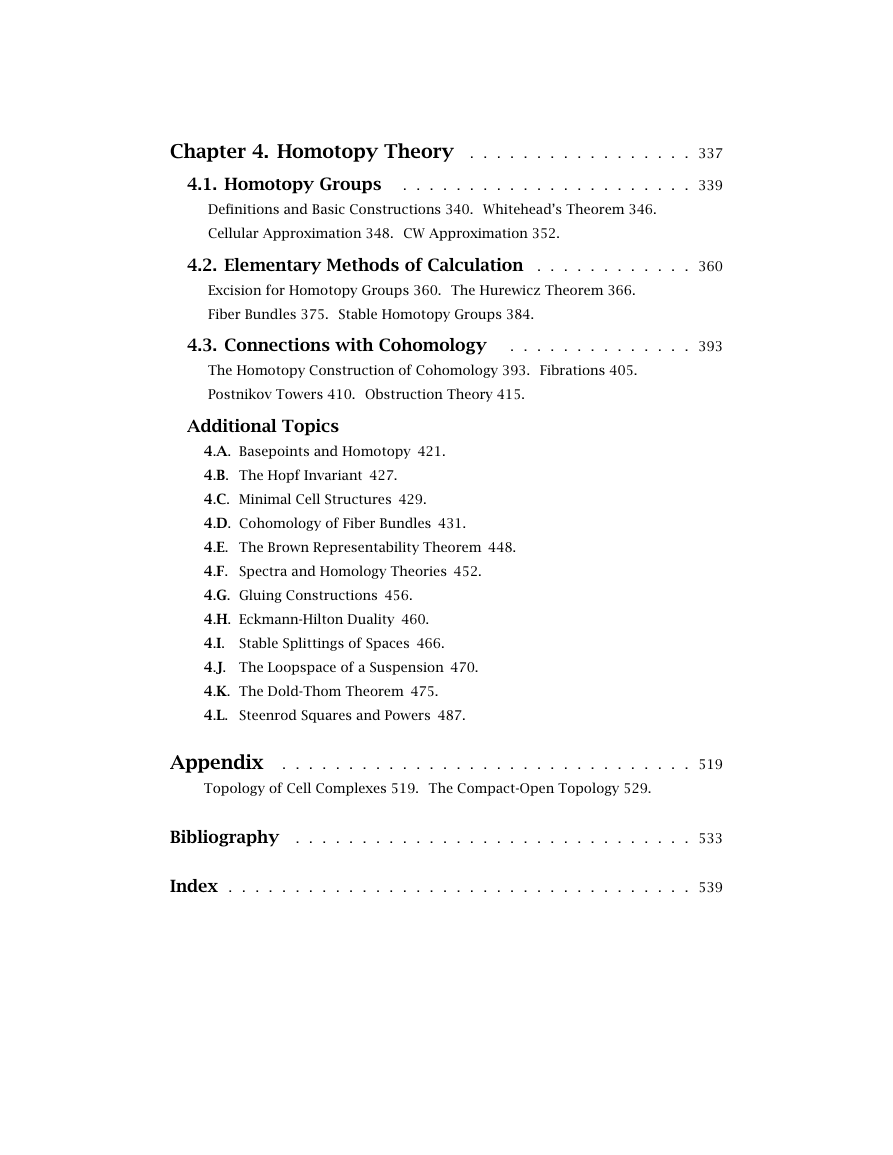
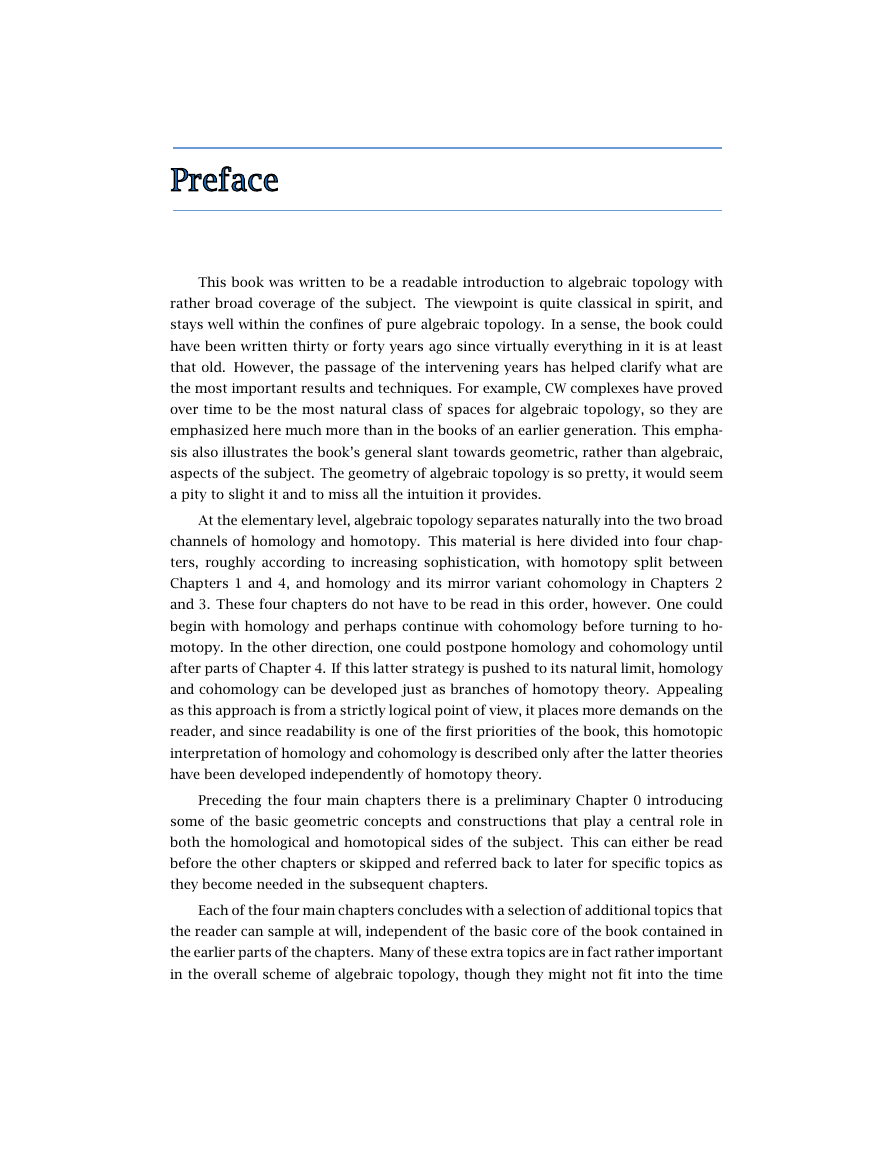
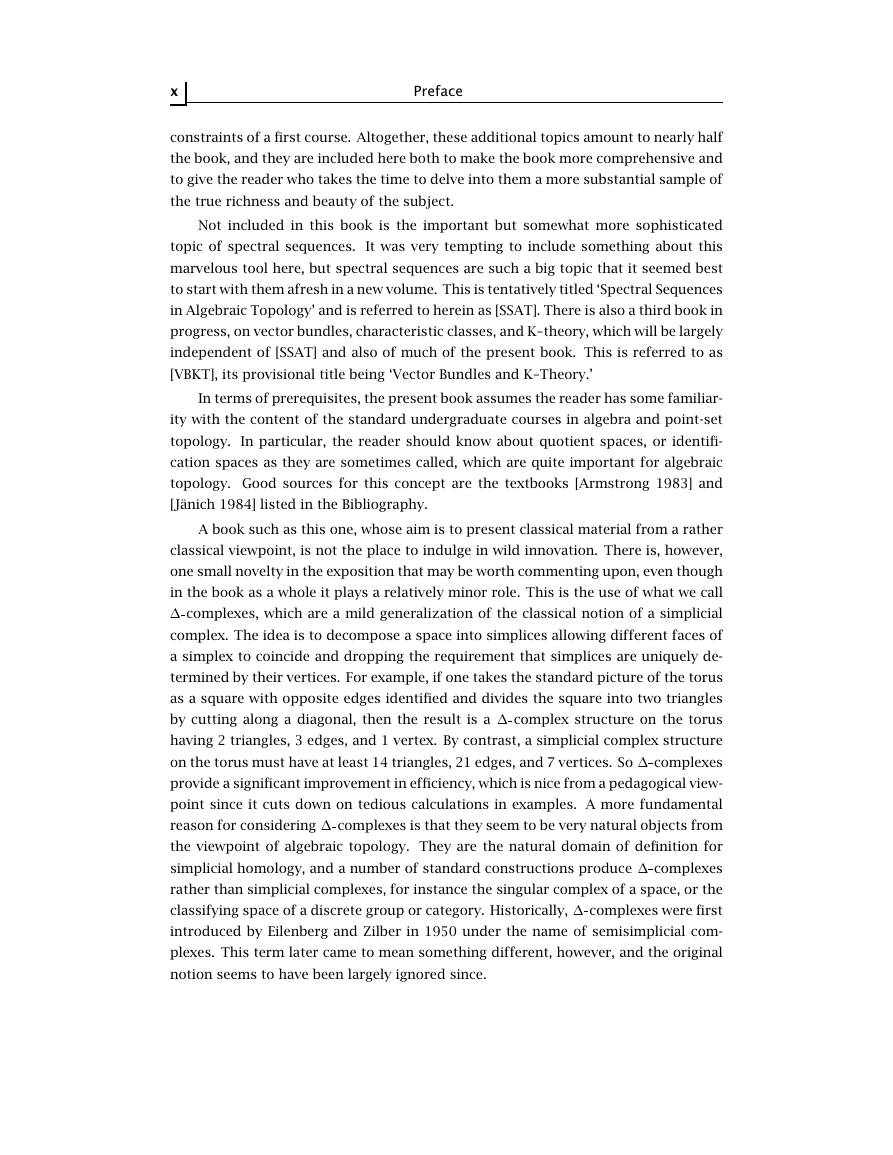
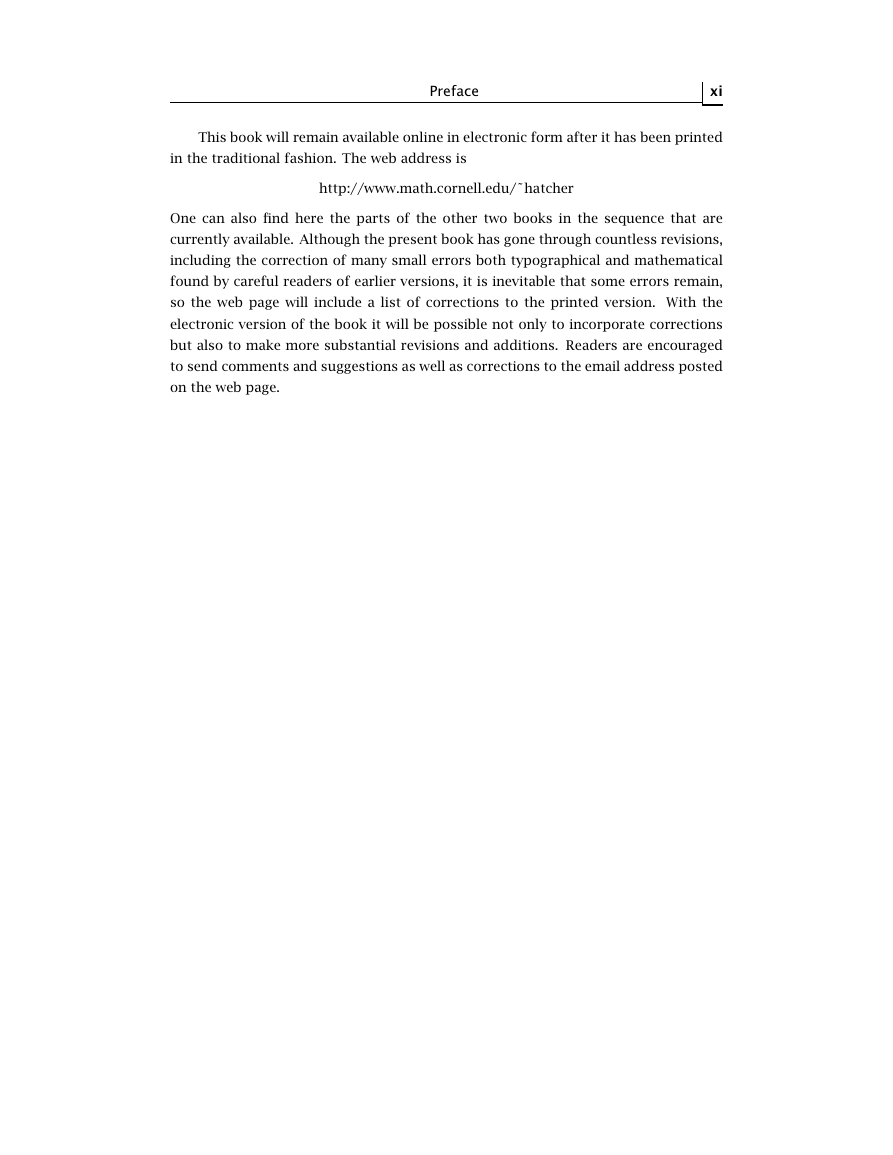








 2023年江西萍乡中考道德与法治真题及答案.doc
2023年江西萍乡中考道德与法治真题及答案.doc 2012年重庆南川中考生物真题及答案.doc
2012年重庆南川中考生物真题及答案.doc 2013年江西师范大学地理学综合及文艺理论基础考研真题.doc
2013年江西师范大学地理学综合及文艺理论基础考研真题.doc 2020年四川甘孜小升初语文真题及答案I卷.doc
2020年四川甘孜小升初语文真题及答案I卷.doc 2020年注册岩土工程师专业基础考试真题及答案.doc
2020年注册岩土工程师专业基础考试真题及答案.doc 2023-2024学年福建省厦门市九年级上学期数学月考试题及答案.doc
2023-2024学年福建省厦门市九年级上学期数学月考试题及答案.doc 2021-2022学年辽宁省沈阳市大东区九年级上学期语文期末试题及答案.doc
2021-2022学年辽宁省沈阳市大东区九年级上学期语文期末试题及答案.doc 2022-2023学年北京东城区初三第一学期物理期末试卷及答案.doc
2022-2023学年北京东城区初三第一学期物理期末试卷及答案.doc 2018上半年江西教师资格初中地理学科知识与教学能力真题及答案.doc
2018上半年江西教师资格初中地理学科知识与教学能力真题及答案.doc 2012年河北国家公务员申论考试真题及答案-省级.doc
2012年河北国家公务员申论考试真题及答案-省级.doc 2020-2021学年江苏省扬州市江都区邵樊片九年级上学期数学第一次质量检测试题及答案.doc
2020-2021学年江苏省扬州市江都区邵樊片九年级上学期数学第一次质量检测试题及答案.doc 2022下半年黑龙江教师资格证中学综合素质真题及答案.doc
2022下半年黑龙江教师资格证中学综合素质真题及答案.doc